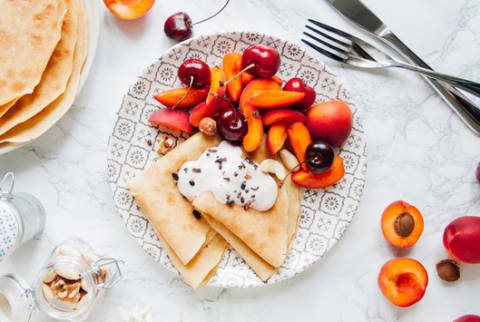Advertisement
The Age-Reversing Ingredient You Should Be Cooking With (But Probably Aren't)


As a self-professed Tea Queen, I have a cup nearby at almost all times. I have teas I drink in the morning, teas I drink post-lunch and before bed, teas I drink to make myself calm, and teas I drink to perk myself up. Teas are win-win: They taste delicious, and they're incredibly anti-inflammatory and longevity-inducing (many of the Blue Zones, so-called for their notably long life spans, attribute their agelessness to tea). Numerous studies point to1 the ability of tea to help prevent cancer, protect heart health, increase resting metabolic rate (important for everything from dropping a few pounds to managing diabetes), and make your skin glow. It's no wonder it's the most widely consumed beverage in the world—but I knew we could do even more with it.
One day, while drinking my 5 p.m. sweet rose tulsi tea (the perfect wind-down from work blend, but that's another story), it occurred to me that tea was, essentially, flavored water. I use water, or a type of flavored water (broth), almost daily in my cooking—for my oatmeal, to cook my pasta in, for my quinoa, in my smoothies. I looked from my mug to my stove and back again.
What if, I thought, I started cooking with my tea?
I began experiments that evening. I warmed some coconut milk on the stove until it just boiled, then turned off the heat, added a few bags of my tulsi rose tea and covered the pot. I let it steep for about 10 minutes before discarding the bags and using the milk to make quinoa. The result? Everything I loved about my tea—a sweet, faintly woody rose flavor—diffusing throughout the lightly coconut-scented quinoa. I tossed in some toasted, crushed pistachio, a few chopped figs, and some chopped fresh mint and parsley leaves and voila! The flavors were five-star-restaurant worthy, with a subtle exotic element that my husband couldn't stop complimenting but also couldn't identify.
The first experiment was an utter success. And it only got better from there.
I infused chamomile in my chia pudding, threw some cold green tea in my morning smoothie, and used Earl Grey as a base for the most delicious bergamot-infused dairy-free chocolate milkshake. The tea always added an incredible level of complexity, even to the simplest of dishes. Here are my favorite ways to cook with tea:
1. Use it to infuse whatever liquid you're using.
In the vein of my first coconut milk quinoa, this is the easiest way to harness tea's beautiful flavors and myriad health benefits. Simply heat up whatever liquid the recipe calls for, whether it's water, milk, or broth, and drop in some loose-leaf tea or tea bags. Cover and let steep for 5 minutes for green, black, or white tea (or "true" teas) and 10 minutes for herbal teas, or tisanes. Strain or remove the bags and proceed with the liquid as you normally would.
2. Grind it and toss it into (or rub it on) your food.
You know the matcha craze that's happening right now, where there are matcha cakes and matcha smoothies and matcha chicken pot pie (just kidding on the last one—I think)? That's the same process I'm referring to. Matcha is simply high-grade green tea ground into a fine powder. You can mimic this process with other teas, although for this method, you really want to make sure you're using quite a high-quality blend. Simply take your tea and grind it in a blender, mortar and pestle, spice grinder, or clean coffee grinder. You can use the resulting powder like you would any spice. Try it as a rub for pastured chicken, or toss some in your smoothie as a superfood booster.